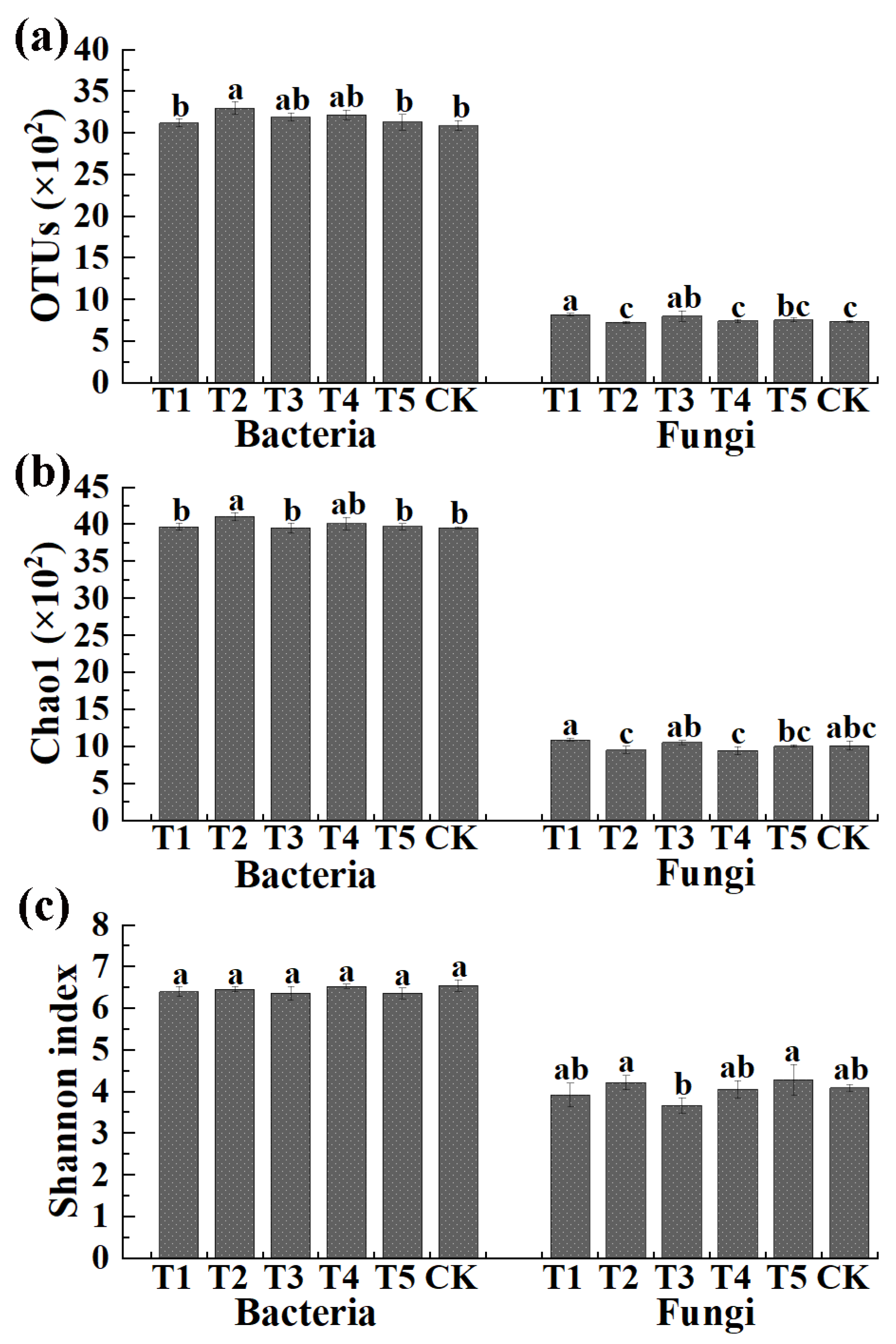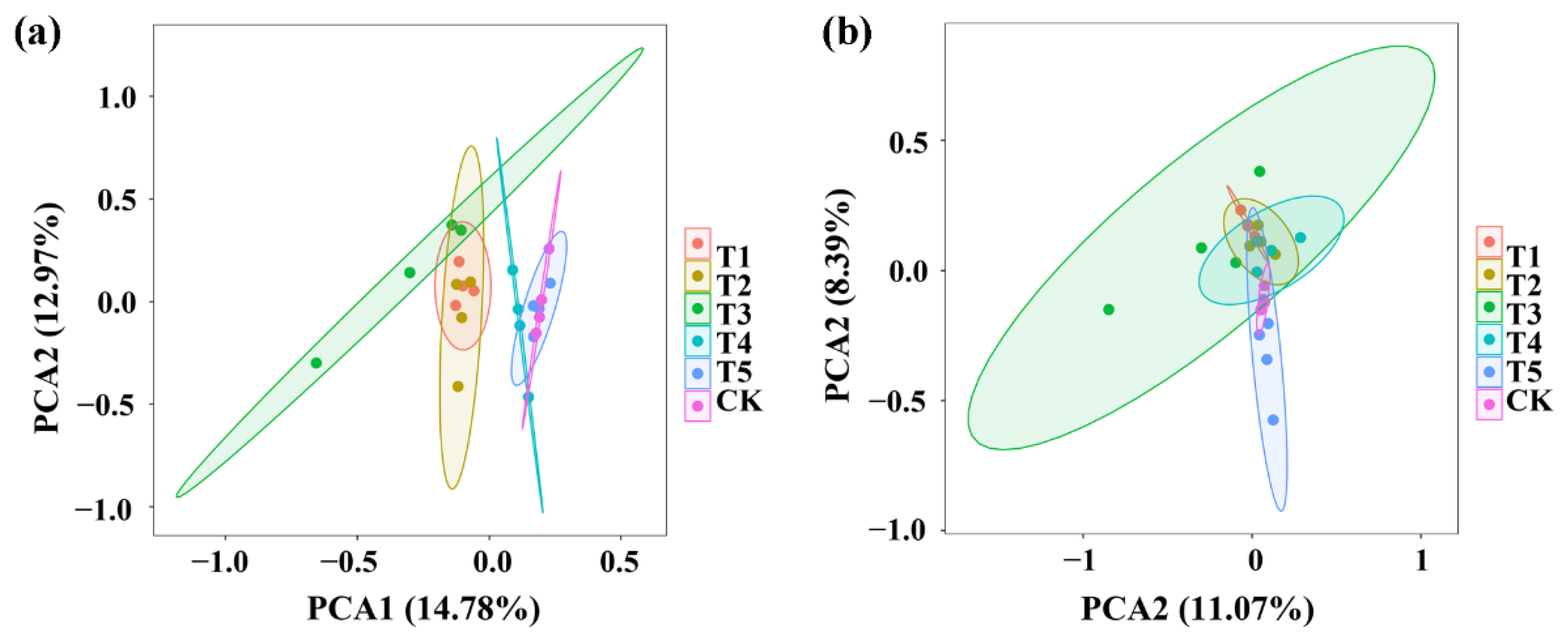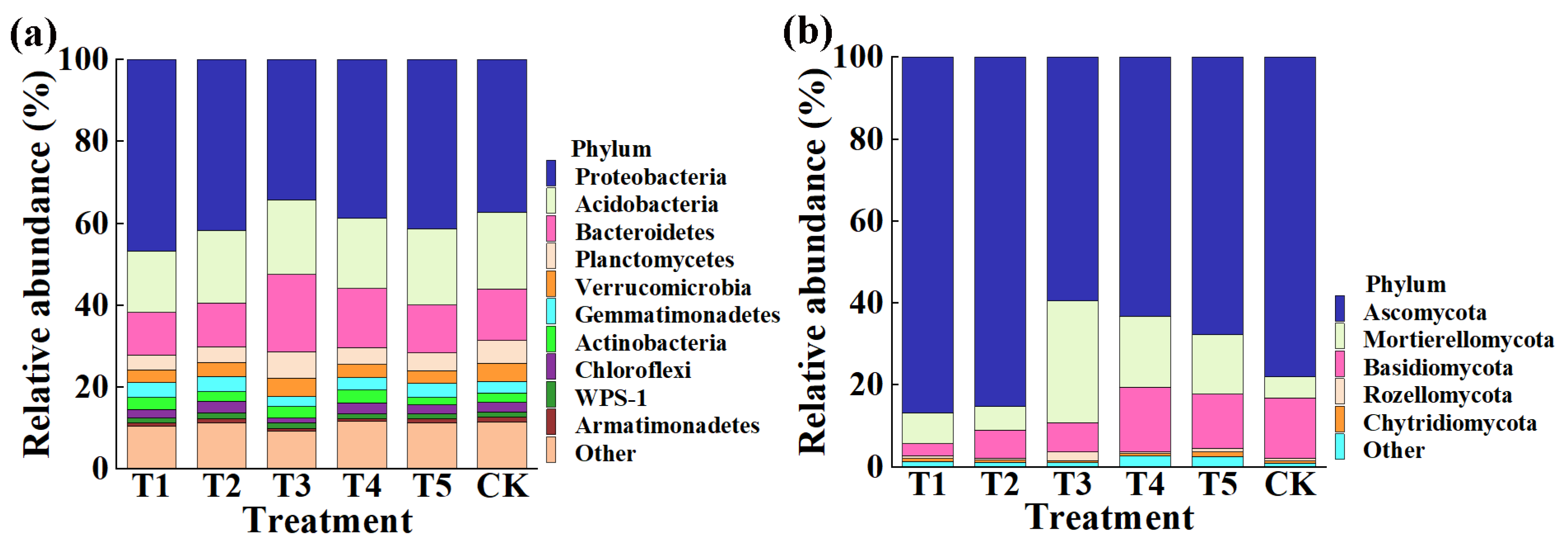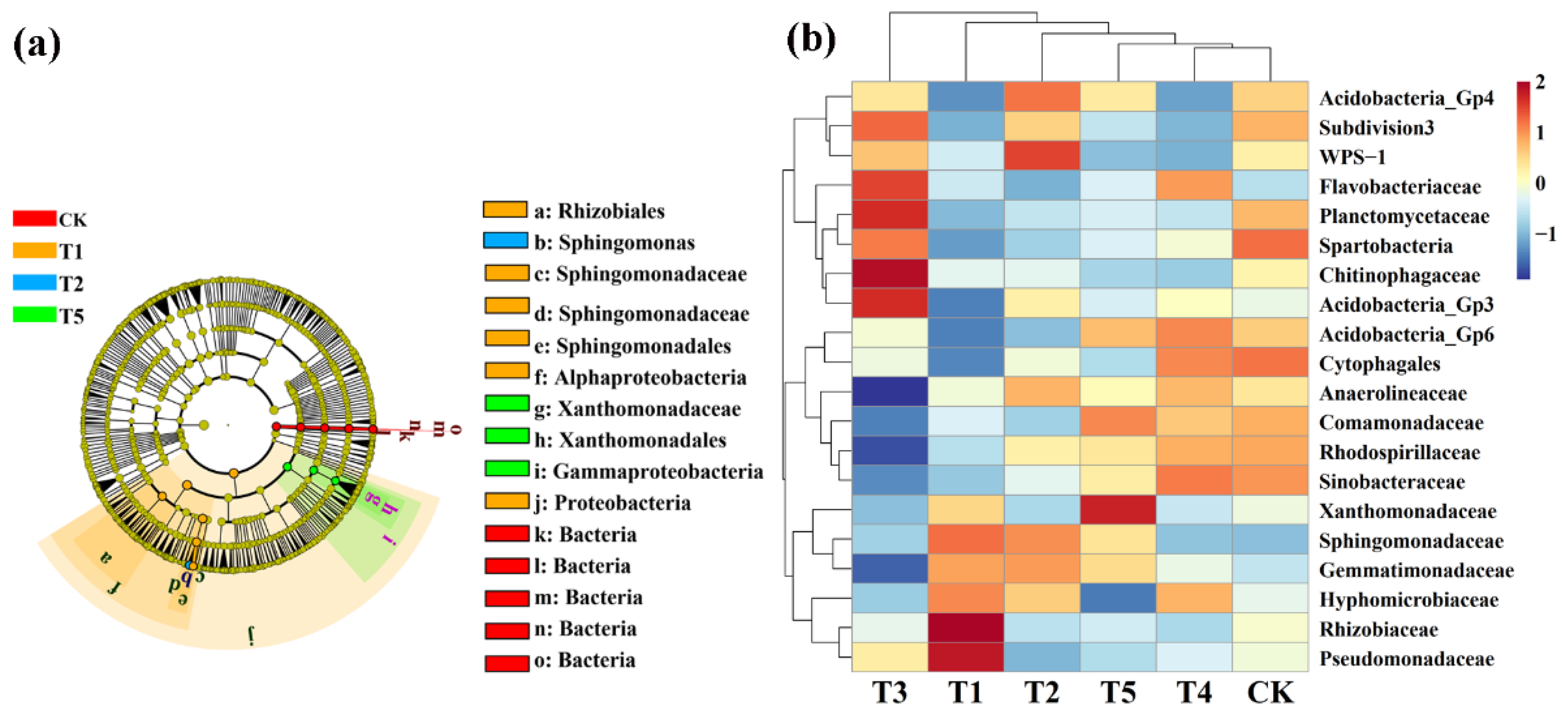Effects of Different Microbial Fertilizers on Growth and Rhizosphere Soil Properties of Corn in Newly Reclaimed Land
Abstract
:1. Introduction
2. Materials and Methods
2.1. Experimental Design
2.2. Measure of Soil and Corn Production
2.3. Soil Genome Sequencing and Analysis
2.3.1. Collection of Rhizosphere Samples and DNA Extraction
2.3.2. Soil Genome Sequencing
2.4. Statistical Analysis
3. Results and Discussion
3.1. Effects of Different Microbial Fertilizers on Corn Production
3.2. Effects of Different Microbial Fertilizers on Soil pH, Organic Matter Content, and Nutrient Elements
3.3. Effects of Different Microbial Fertilizers on the Microbial Community Diversity
3.4. Effects of Different Microbial Fertilizers on the Soil Microbial Community Structure
3.5. Effects of Different Microbial Fertilizers on the Rhizosphere Microbiome and Biomarkers
3.6. Effects of Different Microbial Fertilizers on RDA of Soil Properties and Microbial Communities
4. Conclusions
Author Contributions
Funding
Institutional Review Board Statement
Informed Consent Statement
Data Availability Statement
Conflicts of Interest
References
- Hu, G.C.; Chen, D.H.; Huang, X.P.; Zhou, C.H.; Yu, G.R.; Pan, J.L. The research about balance system of farm land in occupation and supplement: A demonstration from Lin’ancity. J. Agric. 2014, 4, 112–115. [Google Scholar]
- Wang, Z.; Shen, Q.Y.; Shen, J.G.; Zhu, J.; Ma, W.H.; Yang, Y.M. Investigation on soil physical and chemical properties of new cultivated land in Yuhang District and improvement measures. Zhejiang Agric. Sci. 2017, 58, 1467–1470. [Google Scholar]
- Li, X.; Su, Y.; Ahmed, T.; Ren, H.; Javed, M.R.; Yao, Y.; An, Q.; Yan, J.; Li, B. Effects of Different Organic Fertilizers on Improving Soil from Newly Reclaimed Land to Crop Soil. Agriculture 2021, 11, 560. [Google Scholar] [CrossRef]
- Liu, Z.; Cao, S.L.; Sun, Z.H.; Wang, H.Y.; Qu, S.D.; Lei, N.; He, J.; Dong, Q.G. Tillage effects on soil properties and crop yield after land reclamation. Sci. Rep. 2021, 11, 4611. [Google Scholar] [CrossRef] [PubMed]
- Zhu, Q.; Hu, Z.Q.; Liu, X.R.; Wu, Y.J. Topsoil alternatives selection for surface coal-mined land reclamation in Inner Mongolia, China: An experimental study. Int. J. Min. Reclam. Environ. 2021, 35, 421–434. [Google Scholar] [CrossRef]
- Xu, Y.; Pu, L.J.; Zhang, R.S.; Zhu, M.; Zhang, M.; Bu, X.G.; Xie, X.F.; Wang, Y. Effects of agricultural reclamation on soil physicochemical properties in the mid-eastern coastal area of China. Land 2021, 10, 142. [Google Scholar] [CrossRef]
- Larney, F.J.; Angers, D.A. The role of organic amendments in soil reclamation: A review. Can. J. Soil Sci. 2012, 92, 19–38. [Google Scholar] [CrossRef]
- Li, Z.; Bai, T.; Dai, L.; Wang, F.; Tao, J.; Meng, S.; Hu, Y.; Wang, S.; Hu, S. A study of organic acid production in contrasts between two phosphate solubilizing fungi: Penicillium oxalicum and Aspergillus niger. Sci. Rep. 2016, 6, 25313. [Google Scholar] [CrossRef]
- Haas, H. Fungal siderophore metabolism with a focus on Aspergillus fumigates. Nat. Prod. Rep. 2014, 31, 1266–1276. [Google Scholar] [CrossRef] [Green Version]
- Kalam, S.; Basu, A.; Podile, A.R. Functional and molecular characterization of plant growth promoting Bacillus isolates from tomato rhizosphere. Heliyon 2020, 6, e04734. [Google Scholar] [CrossRef]
- Gouda, S.; Kerry, R.G.; Das, G.; Paramithiotis, S.; Shin, H.-S.; Patra, J.K. Revitalization of plant growth promoting rhizobacteria for sustainable development in agriculture. Microbiol. Res. 2018, 206, 131–140. [Google Scholar] [CrossRef]
- Egamberdieva, D.; Adesemoye, A.O. Improvement of crop protection and yield in hostile agroecological conditions with PGPRbased biofertilizer formulations. In Bioformulations: For Sustainable Agriculture; Springer: Berlin/Heidelberg, Germany, 2016; pp. 199–211. [Google Scholar]
- Li, X.Q.; Li, D.Y.; Yan, J.L.; Zhang, Y.; Wang, H.; Zhang, J.Z.; Ahmed, T.; Li, B. Effect of Plant-Growth-Promoting Fungi on Eggplant (Solanum melongena L.) in New Reclamation Land. Agriculture 2021, 11, 1036. [Google Scholar] [CrossRef]
- Li, X.; Yan, J.; Li, D.; Jiang, Y.; Zhang, Y.; Wang, H.; Zhang, J.; Ahmed, T.; Li, B. Isolation and Molecular Characterization of Plant-Growth-Promoting Bacteria and Their Effect on Eggplant (Solanum melongena) Growth. Agriculture 2021, 11, 1258. [Google Scholar] [CrossRef]
- Baran, A.; Mierzwa-Hersztek, M.; Gondek, K.; Tarnawski, M.; Szara, M.; Gorczyca, O.; Koniarz, T. The influence of the quantity and quality of sediment organic matter on the potential mobility and toxicity of trace elements in bottom sediment. Environ. Geochem. Health 2019, 41, 2893–2910. [Google Scholar] [CrossRef] [Green Version]
- Wu, L.Y.; Wen, C.Q.; Qin, Y.J.; Yin, H.Q.; Tu, Q.C.; Nostrand, J.D.V.; Yuan, T.; Yuan, M.T.; Deng, Y.; Zhou, J.Z. Phasing amplicon sequencing on Illumina Miseq for robust environmental microbial community analysis. BMC Microbiol. 2015, 15, 125. [Google Scholar] [CrossRef] [Green Version]
- Ren, H.; Wang, H.; Yu, Z.; Zhang, S.; Qi, X.; Sun, L.; Wang, Z.; Zhang, M.; Ahmed, T.; Li, B. Effect of Two Kinds of Fertilizers on Growth and Rhizosphere Soil Properties of Bayberry with Decline Disease. Plants 2021, 10, 2386. [Google Scholar] [CrossRef]
- Jiang, H.; Lv, L.; Ahmed, T.; Jin, S.; Shahid, M.; Noman, M.; Osman, H.-E.H.; Wang, Y.; Sun, G.; Li, X.; et al. Nanoparticles-Mediated Amelioration of Tomato Bacterial Wilt Disease by Modulating the Rhizosphere Bacterial Community. Int. J. Mol. Sci. 2022, 23, 414. [Google Scholar] [CrossRef]
- Callahan, B.J.; McMurdie, P.J.; Rosen, M.J.; Han, A.W.; Johnson, A.J.A.; Holmes, S.P. DADA2: High-resolution sample inference from Illumina amplicon data. Nat. Methods 2016, 13, 581–583. [Google Scholar] [CrossRef] [Green Version]
- Bokulich, N.A.; Kaehler, B.D.; Rideout, J.R.; Dillon, M.; Bolyen, E.; Knight, R.; Huttley, G.A.; Caporaso, J.G. Optimizing taxonomic classification of marker-gene amplicon sequences with QIIME 2′s q2-feature-classifier plugin. Microbiome 2018, 6, 90. [Google Scholar] [CrossRef]
- Ramette, A. Multivariate analyses in microbial ecology. FEMS Microbiol. Ecol. 2007, 62, 142–160. [Google Scholar] [CrossRef] [Green Version]
- Ahmed, T.; Noman, M.; Jiang, H.; Shahid, M.; Ma, C.; Wu, Z.; Nazir, M.M.; Ali, M.A.; White, J.C.; Chen, J. Bioengineered chitosan-iron nanocomposite controls bacterial leaf blight disease by modulating plant defense response and nutritional status of rice (Oryza sativa L.). Nano Today 2022, 45, 101547. [Google Scholar] [CrossRef]
- Ali, L.; Manzoor, N.; Li, X.; Naveed, M.; Nadeem, S.; Waqas, M.; Khalid, M.; Abbas, A.; Ahmed, T.; Li, B.; et al. Impact of Corn Cob-Derived Biochar in Altering Soil Quality, Biochemical Status and Improving Maize Growth under Drought Stress. Agronomy 2021, 11, 2300. [Google Scholar] [CrossRef]
- Ren, H.Y.; Wang, H.Y.; Qi, X.J.; Yu, Z.P.; Zheng, X.L.; Zhang, S.W.; Wang, Z.S.; Zhang, M.C.; Ahmed, T.; Li, B. The Damage Caused by Decline Disease in Bayberry Plants through Changes in Soil Properties, Rhizosphere Microbial Community Structure and Metabolites. Plants 2021, 10, 2083. [Google Scholar] [CrossRef] [PubMed]
- Doran, J.W.; Parkin, T.B. Defining and assessing soil quality. In Defining Soil Quality for a Sustainable Environment; Doran, J.W., Coleman, D.C., Bezdicek, D.F., Stewart, B.A., Eds.; Soil Science Society of America, Inc.: Madison, WI, USA, 1994; Volume 35, pp. 1–21. [Google Scholar]
- Karlen, D.L.; Mausbach, M.; Doran, J.W.; Cline, R.; Harris, R.; Schuman, G. Soil quality: A concept, definition, and framework for evaluation (a guest editorial). Soil Sci. Soc. Am. J. 1997, 61, 4–10. [Google Scholar] [CrossRef] [Green Version]
- Veum, K.S.; Goyne, K.W.; Kremer, R.J.; Miles, R.J.; Sudduth, K.A. Biological indicators of soil quality and soil organic matter characteristics in an agricultural management continuum. Biogeochemistry 2014, 117, 81–99. [Google Scholar] [CrossRef]
- Sogi, D.S.; Siddiq, M.; Dolan, K.D. Total phenolics, carotenoids and antioxidant properties of tommy atkin mango cubes as affected by drying techniques. LWT Food Sci. Technol. 2015, 62, 564–568. [Google Scholar] [CrossRef]
- Qu, B.P.; Liu, Y.X.; Sun, X.Y.; Li, S.Y.; Wang, S.Y.; Xiong, K.Y.; Yun, B.H.; Zhang, H. Effect of various mulches on soil physicochemical properties and tree growth (Sophora japonica) in urban tree pits. PLoS ONE 2019, 14, e0210777. [Google Scholar] [CrossRef] [Green Version]
- Jiang, S.Q.; Yu, Y.N.; Gao, R.W.; Wang, H.; Zhang, J.; Li, R.; Long, X.H.; Shen, Q.R.; Chen, W.; Cai, F. High-throughput absolute quantification sequencing reveals the effect of different fertilizer applications on bacterial community in a tomato cultivated coastal saline soil. Sci. Total Environ. 2019, 687, 601–609. [Google Scholar] [CrossRef]
- Jiang, X.M.; Zhang, F.H.; Li, J.H.; Fan, H.; Cheng, Z.B.; Wang, K.Y. Effects of bio-organic fertilizer on soil microbiome against Verticilliumdahliae. Int. J. Agric. Biol. 2016, 18, 923–931. [Google Scholar]
- Asaf, S.; Numan, M.; Khan, A.L.; Al-Harrasi, A. Sphingomonas: From diversity and genomics to functional role in environmental remediation and plant growth. Crit. Rev. Biotechnol. 2020, 40, 138–152. [Google Scholar] [CrossRef]
- Park, D.; Kim, H.; Yoon, S. Nitrous oxide reduction by an obligate aerobic bacterium, Gemmatimonas aurantiaca strain T-27. Appl. Environ. Microbiol. 2017, 83, e00502–e00517. [Google Scholar] [CrossRef] [Green Version]
- Chee-Sanford, J.; Tian, D.; Sanford, R. Consumption of N2O and other N-cycle intermediates by Gemmatimonas aurantiaca strain T-27. Microbiology 2019, 165, 1345–1354. [Google Scholar] [CrossRef]








| Fertilizer | OMC (%) | NPK Content (%) | MS Content (million/g) | Others |
|---|---|---|---|---|
| TMF | 80 | 5.0 | 2.0 | humic acid, medium, and trace elements |
| CMA | 45 | - | 5.0 | biocarbon, fulvic acid, humic acid |
| SMF | 50 | 5.0 | 4.0 | seaweed protein, and polysaccharide, organic Ca (1.0%) |
| SM | 30 | 4.0 | - | - |
| CCF | - | 48.0 | - | NO3 and K2SO4 |
| Treatments | Weight of Air-Dried Corn Ears (kg) | |||||
|---|---|---|---|---|---|---|
| 2019 | GPE% | 2020 | GPE% | 2021 | GPE% | |
| TMF | 14.10 ± 1.23 | 30.19 ab | 15.47 ± 1.57 | 52.63 ab | 16.65 ± 2.09 | 59.33 ab |
| CMA | 14.23 ± 1.01 | 31.39 ab | 15.30 ± 1.83 | 50.99 bc | 16.03 ± 0.32 | 53.43 ab |
| SMF | 15.47 ± 2.67 | 42.84 a | 18.63 ± 2.05 | 71.05 ab | 17.37 ± 2.15 | 66.19 a |
| SM | 15.40 ± 2.70 | 42.20 a | 17.33 ± 0.86 | 83.88 a | 18.07 ± 2.28 | 72.89 a |
| CCF | 12.13 ± 0.40 | 12.00 b | 12.23 ± 0.75 | 20.72 c | 13.68 ± 2.18 | 30.94 b |
| Control | 10.83 ± 0.45 | - | 10.13 ± 0.72 | - | 10.45 ± 1.67 | - |
| Treatments (kg/m2) | pH | OMC (g/kg) | ||||
|---|---|---|---|---|---|---|
| 2019 | 2020 | 2021 | 2019 | 2020 | 2021 | |
| TMF | 6.63 ± 0.05 a | 6.61 ± 0.10 ab | 6.74 ± 0.15 a | 14.07 ± 1.42 bc | 18.07 ± 0.95 c | 22.87 ± 1.18 b |
| CMA | 6.40 ± 0.54 a | 6.47 ± 0.13 b | 6.60 ± 0.30 a | 12.37 ± 0.46 c | 17.00 ± 1.80 c | 19.80 ± 1.61 c |
| SMF | 6.66 ± 0.07 a | 6.82 ± 0.13 a | 6.73 ± 0.07 a | 13.80 ± 1.31 bc | 26.07 ± 1.12 a | 27.77 ± 1.75 a |
| SM | 6.47 ± 0.51 a | 6.61 ± 0.2 ab | 6.81 ± 0.05 a | 15.77 ± 1.27 ab | 22.23 ± 0.40 b | 24.97 ± 1.16 b |
| CCF | 6.65 ± 0.18 a | 6.60 ± 0.10 ab | 6.50 ± 0.17 a | 16.42 ± 1.32 a | 13.33 ± 1.19 d | 13.17 ± 0.68 d |
| Control | 6.50 ± 0.09 a | 6.53 ± 0.21 ab | 6.55 ± 0.16 a | 13.37 ± 0.97 c | 12.60 ± 1.00 d | 12.80 ± 0.53 d |
| Treatments (kg/m2) | Total N (g/kg) | Available P (mg/kg) | Available K (mg/kg) | ||||||
|---|---|---|---|---|---|---|---|---|---|
| 2019 | 2020 | 2021 | 2019 | 2020 | 2021 | 2019 | 2020 | 2021 | |
| TMF | 0.66 ± 0.04 c | 1.19 ± 0.07 a | 1.34 ± 0.10 ab | 17.13 ± 0.84 ab | 18.40 ± 0.94 b | 23.07 ± 1.19 d | 396.10 ± 12.36 a | 422.64 ± 15.10 a | 424.65 ± 13.97 ab |
| CMA | 0.78 ± 0.04 bc | 1.08 ± 0.05 ab | 1.21 ± 0.13 bc | 16.32 ± 1.56 abc | 18.45 ± 0.10 b | 23.90 ± 0.35 d | 390.93 ± 13.61 a | 401.15 ± 14.53 b | 410.33 ± 11.40 b |
| SMF | 0.89 ± 0.07 ab | 1.18 ± 0.07 a | 1.55 ± 0.26 a | 17.53 ± 1.41 a | 19.53 ± 0.76 ab | 33.90 ± 1.06 a | 383.58 ± 17.44 ab | 411.31 ± 3.58 ab | 419.77 ± 5.21 b |
| SM | 0.92 ± 0.13 a | 0.97 ± 0.12 bc | 1.22 ± 0.07 bc | 14.33 ± 0.90 c | 18.02 ± 1.09 b | 29.67 ± 0.97 b | 379.41 ± 3.26 ab | 413.85 ± 11.09 ab | 427.57 ± 6.08 ab |
| CCF | 0.73 ± 0.02 c | 0.96 ± 0.09 bc | 0.96 ± 0.13 d | 17.09 ± 1.13 ab | 20.57 ± 1.25 a | 26.63 ± 0.68 c | 391.10 ±15.61 a | 417.22 ± 3.66 a | 439.59 ± 11.71 a |
| Control | 0.69 ± 0.10 c | 0.91 ± 0.04 c | 1.05 ± 0.04 cd | 14.98 ± 0.47 bc | 12.47 ± 0.67 c | 13.3 ± 0.61 e | 365.21 ± 10.06 b | 337.63 ± 3.19 c | 334.10 ± 3.25 c |
| Treatments (kg/m2) | Exchangeable Ca (cmol (1/2 Ca2+)/kg) | Exchangeable Mg (cmol (1/2 Mg2+)/kg) | ||||
|---|---|---|---|---|---|---|
| 2019 | 2020 | 2021 | 2019 | 2020 | 2021 | |
| TMF | 13.04 ± 1.01 b | 12.64 ± 0.20 ab | 7.25 ± 0.50 b | 0.98 ± 0.04 abc | 0.50 ± 0.02 c | 0.97 ± 0.08 b |
| CMA | 14.27 ± 0.91 ab | 13.93 ± 0.96 a | 7.46 ± 0.70 b | 0.87 ± 0.08 c | 0.61 ± 0.05 bc | 1.02 ± 0.04 ab |
| SMF | 10.83 ± 0.65 c | 11.23 ± 0.59 b | 25.28 ± 0.68 a | 1.04 ± 0.06 ab | 0.60 ± 0.02 bc | 1.11 ± 0.07 ab |
| SM | 10.32 ± 0.17 c | 11.57 ± 0.14 b | 7.55 ± 0.56 b | 0.96 ± 0.12 abc | 0.72 ± 0.03 a | 1.17 ± 0.11 a |
| CCF | 15.03 ± 1.47 a | 11.76 ± 0.98 b | 7.45 ± 0.65 b | 1.09 ± 0.05 a | 0.61 ± 0.03 b | 0.95 ± 0.11 b |
| Control | 10.90 ± 1.17 c | 11.30 ± 1.31 b | 6.06 ± 0.26 c | 0.94 ± 0.03 bc | 0.70 ± 0.13 ab | 1.05 ± 0.06 ab |
| Soil Environment | Contribution at the Bacterial Genus Level (%) | Contribution at the Fungal Genus Level (%) |
|---|---|---|
| pH | 33.17 | 0.80 |
| Organic matter content | 28.82 | 30.38 |
| Total N | 22.57 | 22.00 |
| Available P | 21.82 | 39.44 |
| Available K | 7.37 | 26.95 |
| Exchangeable Ca | 69.89 | 29.30 |
| Exchangeable Mg | 8.96 | 35.62 |
Publisher’s Note: MDPI stays neutral with regard to jurisdictional claims in published maps and institutional affiliations. |
© 2022 by the authors. Licensee MDPI, Basel, Switzerland. This article is an open access article distributed under the terms and conditions of the Creative Commons Attribution (CC BY) license (https://creativecommons.org/licenses/by/4.0/).
Share and Cite
Li, X.; Lu, Q.; Li, D.; Wang, D.; Ren, X.; Yan, J.; Ahmed, T.; Li, B. Effects of Different Microbial Fertilizers on Growth and Rhizosphere Soil Properties of Corn in Newly Reclaimed Land. Plants 2022, 11, 1978. https://doi.org/10.3390/plants11151978
Li X, Lu Q, Li D, Wang D, Ren X, Yan J, Ahmed T, Li B. Effects of Different Microbial Fertilizers on Growth and Rhizosphere Soil Properties of Corn in Newly Reclaimed Land. Plants. 2022; 11(15):1978. https://doi.org/10.3390/plants11151978
Chicago/Turabian StyleLi, Xuqing, Qiujun Lu, Dingyi Li, Daoze Wang, Xiaoxu Ren, Jianli Yan, Temoor Ahmed, and Bin Li. 2022. "Effects of Different Microbial Fertilizers on Growth and Rhizosphere Soil Properties of Corn in Newly Reclaimed Land" Plants 11, no. 15: 1978. https://doi.org/10.3390/plants11151978








